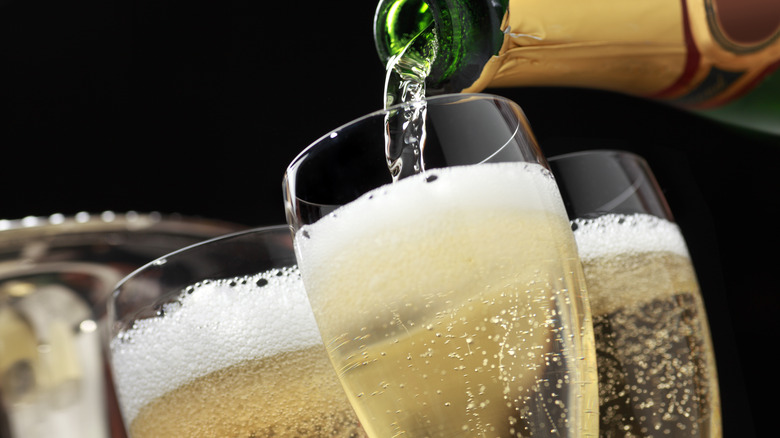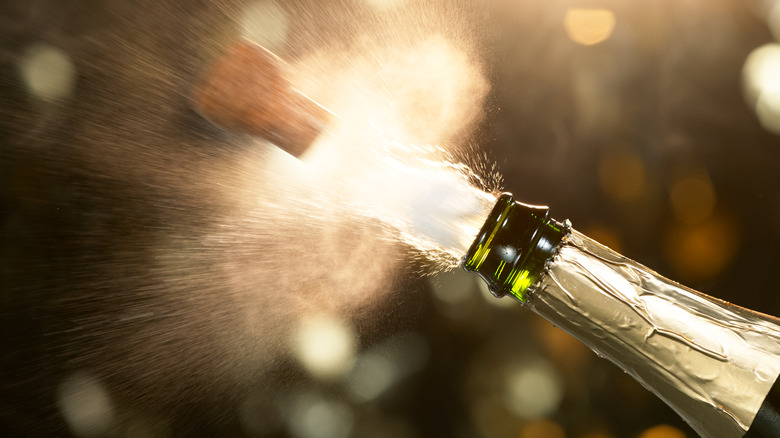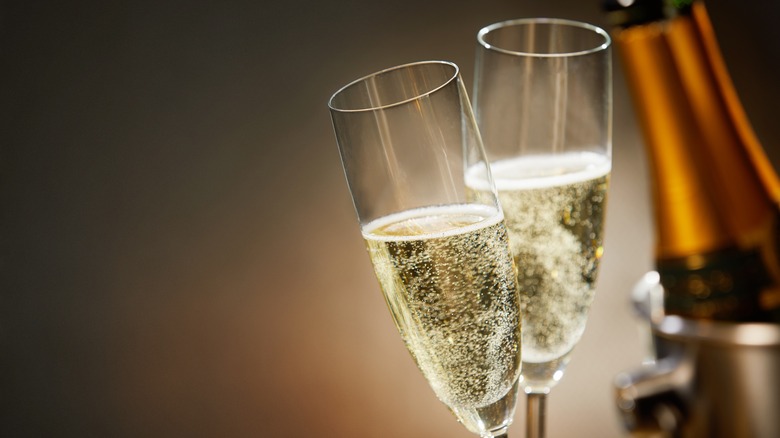Why Champagne Bubbles Fizz Straight Up And Not Sideways
The report is in: Champagne is good for you, and it's hard to imagine Champagne without bubbles. This bubbly effervescence, the result of secondary fermentation within each bottle, is what gives the iconic French wine its essential character. Famously, of course, the discovery of the méthode champenoise is attributed to a Benedictine monk named Dom Perignon, who reputedly figured out how to add bubbles in 1697. Whether this claim is historically accurate or not is still hotly debated, but it is a great story. Even better is Dom Perignon's supposed description of the magical event: "I am drinking the stars," he apocryphally exclaimed, per Wired.
The chemical processes behind Champagne's bubbles are both absurdly simple and enormously complicated. On the surface, it's the creation of carbon dioxide gases during Champagne's secondary fermentation that is responsible for the wine's fizzy effervescence. But it's what's below the surface that's really interesting. Each glass of Champagne contains about one million bubbles — a remarkable figure — and these bubbles travel straight up, not sideways as in many other sparkling beverages.
How and why does this happen? This is where it gets complicated. If you're not familiar with the terms vorticity and surfactant, you're in good company. Almost no one else is either, outside of winemakers and scientists. But both are important factors in determining the motion of Champagne bubbles. Surfactants such as lecithin reduce the surface tension in Champagne bubbles, allowing chains of bubbles to develop with the necessary vorticity — or spinning motion — for them to rise directly upwards.
Chemistry and physics in Champagne bubbles
If you find this concept challenging, you are again in good company. So let's break down these processes in words that are less scientific. When the cork is popped on a bottle of Champagne, an enormous amount of carbon dioxide gas that was created during the in-bottle fermentation must rapidly be diffused — or spread out. Most of this gas simply escapes into the air, accounting for the fog cloud seen briefly when a bottle is opened. But enough of it remains in the wine (about 20% of the total gas) to create Champagne's distinctive bubbles. These bubbles, however, are unlike those found in most other sparkling or carbonated beverages. In fact, only the bubbles in a few varieties of beer exhibit a flow pattern similar to Champagne.
"Our intuition, from studying bubble dynamics, is that bubbles rising in line do not follow a straight line," noted Professor Roberto Zeni in The Guardian. "The wake behind each bubble knocks out the trailing bubble behind to the side." That may be typical, but it's not what happens with Champagne. Champagne bubbles have a different kind of wake, and the reason for this can be traced to some of the wine's specific flavor molecules. These flavor molecules (lecithin, for example) have surfactant qualities, meaning they reduce surface tension. Not only does this change the nature of the wake, but it also changes the way the bubbles configure together and the way they rise in the glass.
The flow pattern of Champagne bubbles
Surfactants, like the bubbles themselves, have their origin in Champagne's secondary fermentation process. After sugar and yeast have fermented within the bottle, sediment is formed from dead yeast cells. Commonly referred to as lees, this sediment is ultimately removed through a process known as disgorgement before Champagne is sold. But while the bottle's contents are still aging, lees contribute to the formation of glycoproteins (a molecule made of protein and carbohydrate chains) in the wine, including fatty acids such as lecithin. The latter, in fact, is one of the flavor molecules whose surfactant qualities are so important to Champagne's inimitable bubbles.
Champagne's surfactant-associated flavor molecules, in essence, make it easier for the bubbles to rise rapidly to the top of the glass where they then pop to create the wine's characteristic fizzing effect. In comparison to water, for example, Champagne's surface tension is 30% lower while its viscosity is 50% greater.
Surface tension-lowering surfactants aren't just important for this reason alone, however. They actually help to set an entire sequence of events in motion. For instance, because a Champagne bubble's wake is not pushing subsequent bubbles to the side, actual bubble chains can now begin to form. As it turns out, these extended bubble chains help to create the spinning motion — or vorticity, if you like — that causes Champagne bubbles to rise straight up in the glass, rather than sideways.



